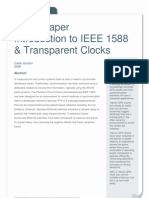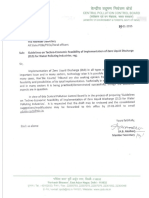Ieee 1588
Ieee 1588
Uploaded by
raghavendran raghuCopyright:
Available Formats
Ieee 1588
Ieee 1588
Uploaded by
raghavendran raghuOriginal Title
Copyright
Available Formats
Share this document
Did you find this document useful?
Is this content inappropriate?
Copyright:
Available Formats
Ieee 1588
Ieee 1588
Uploaded by
raghavendran raghuCopyright:
Available Formats
Synchronizing Device Clocks
Using IEEE 1588 and Blackfin
Embedded Processors
and operating conditions of the individual oscillators would limit
the ability of the clocks to operate synchronously. Some possible
simplistic solutions to address these limitations include:
By Jiang Wu and Robert Peloquin
All the devices could utilize oscillators with nearly identical
characteristics. This approach is impractical due to the difficulty
of acquiring nearly identical oscillators and keeping them from
drifting apart over time. More importantly, each oscillator will
be subjected to different operating conditions.
Introduction
The IEEE 1588 standard, introduced in 2002, defines a protocol
to synchronize distributed clocks on a network. It is becoming
the preferred clock synchronization method for many different
applications, including test and measurement, telecommunications,
and multimedia streaming. This standardized method for
synchronizing clocks is cost-effective, supports heterogeneous
systems, and provides nanosecond-level synchronization precision.
This article provides an introduction to both the original IEEE
1588-2002 standard and the enhancements incorporated as part
of the updated IEEE 1588-2008 version. Dedicated hardware
support for IEEE 1588 has been integrated into the ADSP-BF5181
Blackf in embedded processor because of the increasing
importance of IEEE 1588 in some of its targeted applications. An
overview of its capabilities is provided, followed by an example
showing clock synchronization performance results obtained by
an ADSP-BF518 processor solution.
What Time Is It?
It is common for a system to need to maintain its own sense of time
using a local oscillator. Figure 1 shows how hardware and software
combine to generate time information within a system.
FREQUENCY
HARDWARE
OSCILLATOR
COUNTER
CONVERSION
SOFTWARE
TIME
HOUR:MIN:SEC
EPOCH
DIVIDER
NUMBER OF
PULSES
H:M:S TIME
API FUNCTIONS
CLOCK OUTPUT
LOCAL TIME SYSTEM
APPLICATION
APPLICATION HARDWARE
APPLICATION SOFTWARE
Figure 1. Local timekeeping.
This time information can be used by both hardware and software
resources within the system. In hardware, one or more physical
clock signals (clock outputs) are derived from the oscillators clock
and can be used to drive or trigger other parts of the system. The
time maintained in software is typically referred to as system time.
The system time can be represented in the form of numbers of clock
pulses or in second/nanosecond notation. The system software
derives the time from the number of oscillator clock pulses and
its frequency information, and provides application-programminginterface (API) functions that other parts of the software use to
retrieve and set the time. If an absolute time is desired, the provided
time is associated with a predefined epoch, which identifies a
reference point in time.
Synchronize Your Watches
Many applications require two independent devices to operate in
a synchronized fashion. If each device were to rely solely on its
own oscillator, differences between the specific characteristics
Analog Dialogue 43-11, November (2009)
All the devices could use a single physical oscillator. This is only feasible
for distributed systems in close proximity; a high-frequency clock
signal cannot be reliably delivered over a long distance.
If all the devices are interconnected via a communications network
such as Ethernet, they can dynamically adjust their individual clocks
to a single master clock by exchanging time messages over the
network. With network time protocol (NTP), the traditional time
synchronization protocol, every device in the system adjusts
its clock according to the time information it retrieves from
an NTP time server. However, this protocol can only achieve
synchronization accuracy on the order of milliseconds.
IEEE 1588 defines a newer protocol capable of nanosecond
synchronization accuracy. How it can achieve this level of clock
synchronization is discussed in the following sections.
What IEEE 1588 Does
The IEEE 1588 standard defines a protocol for time-synchronizing
devices that are geographically dispersed but interconnected by
some form of communications technology, for example, Ethernet.
By exchanging timing messages between devices they can maintain
the same absolute system time, which is represented in seconds
and nanoseconds.
An intuitive way to achieve this goal is for one device, which has
the best (most accurate) clock, and is designated as the masterclock device, to broadcast its time to the other devices. The other
devices will adjust their times to match the time sent by the master
clock. This solution has several limitations, though:
1. The master-clock device cannot broadcast the time at
infinitesimal intervals, so the slave clock devices have to use
their own independent and inferior oscillators to interpolate
the time points between two broadcasts from the master-clock
device. This results in degraded synchronization during the
time between updates from the master clock.
2. Delays inevitably exist on the broadcast path, with magnitudes
depending on the communications technologythe time that
a physical signal takes to travel along a wire from one device to
another, for example. This delay results in an additional offset
between the master clock and each slave clock.
3. Differences among the broadcast paths between the masterclock device and each slave-clock device will further degrade
the synchronization between individual slave-clock devices.
IEEE 1588 specifies a protocol that solves the second and third
problems by measuring path delay. It also allows the slave clock
to be adjusted to match the master clocks pace so as to mitigate
the first problem. Where possible, the first problem can be
further reduced by using smaller broadcasting intervals and
higher-quality oscillators.
How IEEE 1588 Measures Communication Delay
IEEE 1588-2002 2 def ines four messages to measure the
communication delay of the forward (master to slave) and
backward (slave to master) paths: Sync, Followup, DelayReq, and
DelayResp. The newer version, IEEE 1588-2008,3 provides further
mechanisms to measure the peer-to-peer delay with three additional
messages: PdelayReq, PdelayResp, and PdelayRespFollowup.
www.analog.com/analogdialogue
Among these messages, Sync, DelayReq, PdelayReq, and
PdelayResp, so-called event messages, must be time-stamped
(recording the local time) when they leave and arrive at a device.
There are two techniques to time-stamp packets:
1. Software time-stamp occurs when the messages are handled
by the software. Usually occurring in the messages receive/
transmit interrupt service routine (ISR), the time-stamp is the
current value of the system time.
2. Hardware time-stamp occurs when the messages physically
arrive at or leave the device. The time-stamp operation is
executed by hardware, which maintains its own continuous
time information.
Either time-stamp method is acceptable in IEEE 1588, but a
hardware time-stamp can provide significantly better precision,
as will be shown below.
Delay from Master-Clock Device to Slave-Clock Device
software has the two times, Ts1' (Sync arrival time) and Tm1'
(Sync departure time). The master-to-slave path delay, Tmsd, is
determined by Equation 1.
Delay from Slave-Clock Device to Master-Clock Device
The DelayReq message is sent by the slave-clock devices, and the
DelayResp message is sent by the master-clock device in response.
With these messages, the slave-clock devices can calculate the
communication path delay from the slave-clock device to the
master-clock device.
At time Ts3 (Figure 3), the slave-clock device software reads
the current local system time (Ts3), inserts it into a DelayReq
message, and sends the message out. After the message is sent,
the slave-clock device software reads the time-stamp to get the
departure time of the message, Ts3', and waits for the response
from the master-clock device.
The messages Sync and Followup are sent by the master-clock
device; it is a slave-clock devices responsibility to receive them
and calculate the communication path delay from the master-clock
device to the slave-clock device.
SLAVE
SOFTWARE
MASTER
HARDWARE
SLAVE
SOFTWARE
Ts1'
SYNC
CARRIES Tm1
SLAVE GETS Ts1'
Ts1
Ts2'
Ts2
FOLLOWUP
CARRIES Tm1'
SLAVE GETS Tm1'
Tm4
HARDWARE
TIME-STAMP
POINT
HARDWARE
TIME-STAMP
POINT
SOFTWARE
TIME-STAMP
POINT
Figure 2. Measuring communication delay between
master-clock and slave-clock devices.
After the Sync message has been sent, the master-clock device
software reads the Sync messages departure time, Tm1', through
the time-stamping unit, inserts it into a Followup message, and
sends that message out at Tm2. This message is received by slaveclock device software at Ts2. At this point, the slave-clock device
MASTER
SENDS DELAYRESP
WHICH CARRIES Tm3'
Tm4'
Ts4'
Ts4
SLAVE GETS Tm3'
HARDWARE
TIME-STAMP
POINT
HARDWARE
TIME-STAMP
POINT
SOFTWARE
TIME-STAMP
POINT
The DelayReq message arrives at the master-clock device at a later
time, Tm3', and is processed by the master software at Tm3. The
software then reads the time-stamp to get the arrival time, Tm3',
puts it into the DelayResp message, and sends to a slave-clock
device at Tm4. When the slave-clock device software receives
the DelayResp message at Ts4, it can extract the time, Tm3', and
calculate the slave-to-master delay, Tsmd, by Equation 2.
(2)
In both Equation 1 and Equation 2, there is an unknown variable,
the master-slave time difference, Tms. So it is not possible to get
either Tmsd or Tsmd individually. However, if one makes the
usually acceptable assumption that the communication path is
symmetric
SOFTWARE
TIME-STAMP
POINT
Tm3
Figure 3. Measuring slave-master communication delay.
SLAVE
HARDWARE
Tm2'
MASTER
SOFTWARE
MASTER
RECEIVES DELAYREQ
SAVES Tm3'
Tm3'
SOFTWARE
TIME-STAMP
POINT
Tm1'
Tm2
MASTER
SENDS
FOLLOWUP
MASTER
HARDWARE
Ts3'
COMMUNICATION
PATH
MASTER
SENDS SYNC
Tm1
COMMUNICATION
PATH
SLAVE
HARDWARE
SLAVE SENDS
DELAYREQ
Ts3
In Figure 2, at time Tm1, the master-clock device software
reads the current local system time (Tm1, the software timestamp), inserts it into a Sync message, and sends the message
out. The message leaves the master-clock device at a later
time, Tm1', which is the hardware time-stamp. It arrives at
slave-clock hardware at Ts1' (slave-clock device local time),
and is received by the slave-clock device software at a later
time, Ts1. The software will read the hardware time-stamp
to get Ts1'. If there is no communication delay, Ts1' should
be equal to (Tm1' + Tms), where Tms is the time difference
between master clock and slave clock. The protocols ultimate
goal is to compensate for this difference.
MASTER
SOFTWARE
(1)
(3)
a key assumption for IEEE 1588 to work correctlythen, adding
Equation 1 and Equation 2 gives
(4)
All these calculations are performed by the slave-clock devices,
since it is they who seek to synchronize themselves to the masterclock device. They get Tm1' from master-clock devices Followup
message, Ts1' from their Rx (reception) time-stamping, Ts3'
from their Tx (transmission) time-stamping, and Tm3' from the
master-clock devices DelayResp message.
Analog Dialogue 43-11, November (2009)
How to Calculate the Time Difference Between a Slave Clock and
Master Clock
Once the communication path delay, Td, is obtained, the slavemaster time difference is easy to calculate, using either Equation 1
or Equation 2, as shown in Equation 5 and Equation 6.
(5)
(6)
How to Adjust the Time of a Slave-Clock Device
With the time difference from the master clock known, each slaveclock device needs to adjust its own local time to match the master
clock. This task has two aspects. First, slave-clock devices need to
adjust their absolute time by adding the time difference to make
their time perfectly match the master-clock time at this moment.
Then, each slave-clock device needs to adjust its clock frequency
to match the frequency of the master clock. We cannot rely on the
absolute time alone, since the time difference is applied only at a
certain period and could be either positive or negative; as a result,
the adjustment will make the slave-clock time jumpy or even run
backward. So, in practice, the adjustment takes two steps.
1. If the time difference is too big, for example, larger than
one second, absolute time adjustment is applied.
2. If the time difference is small, a percentage change of frequency
is applied to slave clocks.
Generally speaking, the system becomes a control loop, where
master-clock time is the reference command, slave-clock time is
the output tracking the master-clock time, and their difference
drives the adjustable clock. PID control, which is commonly
used by many IEEE 1588 implementations, could be used to
achieve specific tracking performance. Figure 4 illustrates this
control loop.
MASTER
TIME
IEEE 1588 CONTROL LOOP
+
CONTROL LAW
ADJUSTABLE
CLOCK
SLAVE
TIME
Figure 4. IEEE 1588 control loop.
Peer-to-Peer Delay
The revised version, IEEE 1588-2008, introduces a new mechanism
for measuring path delay, called peer-to-peer (P2P) delay. By
contrast, the master-slave mechanism discussed in the previous
sections is end-to-end (E2E) delay. In an IEEE 1588-2008-capable
network, a master-clock device can be linked to slave-clock devices
either directly or through multiple hops (stages). The E2E delay is
actually the total delay from a master-clock device to a slave-clock
device, including all the hops in between. However, the P2P delay
is limited to two directly connected devices. The overall delay
along the path is the sum of the P2P delay of all the hops. From
the perspective of preserving path symmetry, the P2P mechanism
provides better accuracy.
As noted earlier, IEEE 1588-2008 includes three additional
messages, PdelayReq, PdelayResp, and PdelayRespFollowup,
to measure P2P delay. They work in a manner similar to that
explained above. Reference 3 provides more details.
Factors Affecting Synchronization Performance
Well-designed IEEE 1588 devices are capable of achieving
highly accurate clock synchronization, but it is important to
recognize the key factors that directly affect performance.
Some of these include:
Analog Dialogue 43-11, November (2009)
1. Path delay: As noted earlier, the path delay measurement of
IEEE 1588 assumes that the communication-path delays are
symmetrical, that is, the transmission delay of the forward path
is equal to the reverse transmission delay. In addition, the delay
should not vary during the delay measurement. Variation in
delay during measurement will produce asymmetry and delay
jitter, which will have a direct impact on the synchronization
precision. While delay symmetry and jitter cannot be controlled
outside the boundaries of an IEEE 1588 device, both path
symmetry and jitter can be improved within the device if
measurements are based on hardware time-stamping. Hardware
time-stamping eliminates the significant jitter resulting from
software time-stampingdue to interrupt latency, context
switch, and thread scheduling.
2. Drift and jitter characteristics of clocks: The frequency
and phase of the master clock represent the inputs of the
tracking control system, and the slave clock is the control
object. Any time-varying behavior of the master clock will
act as a disturbance to the control system and result in both
steady-state- and transient errors. Clocks with less drift and
jitter will, therefore, improve synchronization accuracy.
3. Control law: The control method determines how the errors in
the slave-clock-device time are corrected in the adjustment of
the slave clock. The control-law parameters, including settling
time, overshoot, and steady-state error, will directly affect clock
synchronization performance.
4. Resolution of the clocks: As shown in Figure 1, the resolution
of the local time is determined by the frequency of the clock; the
minimum increment of time is one period of the clock signal.
The IEEE 1588 protocol runs on a time with a resolution of
1 ns for IEEE 1588-2002 and 2 16 ns for IEEE 1588-2008. It
is not practical to have a clock of 216 (!) GHz (or even 1 GHz).
The quantization of the local clocks is expected to affect the
precision of local time measurement and control.
5. How often Sync messages are issued: The frequency
with which the slave clocks are updated ultimately affects
the precision of synchronization. A longer period usually
leads to larger time errors observed at the next Sync, since
the time error is the integral accumulation of the slave-clock
frequency error.
6. How often delay measurement is conducted: Delay
measurement is performed periodically, at intervals based on
the expectation that the delay does not change significantly
between adjacent samples. If the IEEE 1588 network experiences
large delay variations, then increasing the delay-measurement
frequency will improve clock-synchronization performance.
Which Is the Master-Clock?
Having considered how to accurately determine the time difference
between master-clock devices and slave-clock devices, a relevant
question is how to determine which device, among possibly hundreds
of interconnected devices, will serve as the master clock.
IEEE 1588 defines a method called the best master clock (BMC)
algorithm to choose the master clock device. For this approach,
every device of an IEEE 1588 network maintains a data set
describing the nature, quality, stability, unique identifier, and
preference of its local clock. When a device joins an IEEE 1588
network, it will broadcast the dataset of its own clock and receive
the datasets from all other devices. Using the datasets of all the
participating devices, every device runs the same BMC algorithm
to decide on the master clock and its own future status (master
clock or slave clock). Because the same algorithm is executed
independently by all the devices on the same data, all will come
to the same conclusion without requiring any negotiation among
them. More information about the details of the BMC algorithm
can be found in References 2 and 3.
ADSP-BF518 Processors Support for IEEE 1588
The Analog Devices ADSP-BF518 processor recently joined ADIs
Blackfin DSP family. Like its predecessor, the ADSP-BF537,4 it
has a built-in Ethernet media-access controller (EMAC) module. Its
capability to support EMAC functionality within the IEEE 1588
standard is extended by an additional TSYNC module, as well as
extra features to support a wide range of IEEE 1588 applications
on Ethernet. Figure 5 shows the block diagram of the TSYNC
module. The ADSP-BF51x Blackfin Processor Hardware Reference
provides additional information.5
CLOCK
OUT
CLOCK OUTPUT
DRIVER
ADSP-BF518
TSYNC MODULE
PPS
GENERATOR
PPS
OUTPUT
EXTERNAL
CLOCK
MII/RMII
CLOCK
SYSTEM
CLOCK
EVENT
FLAG
CLOCK SOURCE
MUX
ADDEND
ADJUSTABLE
CLOCK
LOCAL TIME
COUNTER
ALARM
GENERATOR
EVENT DETECTION
PTP Tx EVENT
PACKET DETECTION
INTERRUPT
MII Rx
PTP Rx EVENT
PACKET DETECTION
INTERRUPT
REQUEST
Rx
TIMESTAMPING
Figure 5. Block diagram of the ADSP-BF518 processors
TSYNC module.
Packet Detection
The ADSP-BF518 processor can detect and provide hardware
time-stamps for all IEEE 1588 event messages, including both
incoming and outgoing packets. The precision of an IEEE 1588
system depends significantly on both the accuracy of the eventmessage time-stamps and on where they are taken, as these affect
the requirement for symmetry and constancy of path delay. The
ADSP-BF518s TSYNC module keeps monitoring the hardware
interface between the MAC controller and the Ethernet physical
interface transceiver (PHY), that is, the media independent interface
(MII), and produces a hardware time-stamp whenever it detects
an event messagea capability promoting higher synchronization
precision with the ADSP-BF518.
The detection of event messages, designed to be programmable,
can basically be configured to support either IEEE 1588-2002
(default) or IEEE 1588-2008. Furthermore, this programmability
allows for the support of future versions of IEEE 1588, as well as
other general protocols that require time-stampingincluding
being configured to time-stamp every Ethernet packet coming
into and out of the processor.
Flexible Clock Sources
The properties of local clocks are important for the performance
of an IEEE 1588 system. To satisfy requirements of a variety of
applications, the ADSP-BF518 processor allows three options for
the local clock source: system clock, external clock, or Ethernet
clock. If the application has a specific clock requirement, it can
choose external clock and provide a customized clock source. The
Ethernet clock option can offer good precision if the master-clock
devices and the slave-clock devices are connected back-to-back,
since the clock is inferred from the Ethernet lines, and the two
The selected source clock is also driven by the TSYNC module as
an output of the processor, via the specific pin Clockout, to be used
by other parts of the system for local time information.
PPS Output
The pulse-per-second (PPS) signal is a physical representation
of time information. It is nominally a 1-Hz signal with a pulse
at each one-second transition of time. It can be used to control
local devices or to provide an auxiliary time channel in case of
network failure. It can also be used in testing. The phase difference
between PPS signals at two devices is a physical measurement of
their time offset.
The ADSP-BF518 processor provides a flexible PPS output. It
uses a programmable start time (PPS_ST) and period (PPS_P)
to generate a sig nal wit h pulses occur r ing at t he times
( PPS _ ST + n PPS_P), where n = 1, 2, 3 In the basic
usage, t he PPS sig nal ca n be created si mply by set t i ng
PPS _ P to 1 second, and PPS_ST to any future instant as a
multiple of seconds. This PPS output capability allows for its use
as the reference for generation of a periodic signal with a fully
programmable frequency and start time.
Auxiliary Snapshot
Tx
TIMESTAMPING
MII Tx
devices are running on the same clock. A general application can
take the processors system clock as its clock source.
Some applications may need to time-stamp a certain event
indicated by the toggle of a flag signal. The ADSP-BF518s
TSYNC module facilitates this request by providing an auxiliary
snapshot function, using a dedicated pin to accept an external flag.
Toggling the flag will trigger the module to capture the current
local time in a time-stamp register for software to access.
Alarm
If an application needs to execute a task at a specific time, it can
make use of the alarm feature of the TSYNC module. This feature
allows an absolute local time to be set so as to trigger a processor
interrupt when the time arrives. The software can then service
the interrupt and run the task.
Adjustable Clock
The adjustable clock of the TSYNC module is an addend-based
clock. As shown in Figure 6, it takes a fixed input clock signal and
outputs a pulse-steal version of the input: the value of addend is
added to the accumulator at each input clock, and each time the
accumulator overflows the carry bit drives the local-time counter,
which gives the local time in terms of the number of pulses counted.
The frequency of the local clock can be adjusted by changing the
addend, since the addend decides how often the accumulator
overflows, and so how often the local-time counter increments. If
the frequency of the input clock is Fin, and the value of addend is
A, then the local clock frequency will be
(7)
ADDEND-BASED ADJUSTABLE CLOCK
32-BIT
ADDEND
CARRY
INPUT CLOCK
32-BIT
ACCUMULATOR
SUM
64-BIT
LOCAL TIME
COUNTER
SUM
32-BIT
OFFSET
Figure 6. Addend-based adjustable clock.
Analog Dialogue 43-11, November (2009)
Implementation of IEEE 1588 on the ADSP-BF518 Processor
A complete IEEE 1588-2008-compliant system was built on an
ADSP-BF518 processor as shown in Figure 7.
ADSP-BF518 IEEE 1588 systems. 6938 measurements were taken
over a period of approximately 1700 seconds. The resulting mean
error is 0.015 ns, and the standard deviation is 12.96 ns. A Sync
message interval of 0.25 seconds was used for this test.
Conclusion
APPLICATION
ADSP-BF518
PROCESSOR
IEEE 1588-2008 STACK SOFTWARE
TSYNC MODULE
DRIVER SOFTWARE
MAC CONTROLLER
DRIVER SOFTWARE
TSYNC MODULE
HARDWARE
MAC CONTROLLER
HARDWARE
PROCESSOR
SYSTEM CLOCK
PPS
OUTPUT
The IEEE 1588 standard provides a highly accurate, low-cost
method for synchronizing distributed clocks. While hardware
support is not explicitly required for IEEE 1588, hardware-assisted
message detection and time stamping is critical to achieve the
highest level of synchronization precision. The ADSP-BF518
processor provides hardware support for both IEEE 1588-2002
and IEEE 1588-2008, including features that can support a wide
range of applications. High-precision clock synchronization has
been demonstrated by implementing IEEE 1588 technology using
the ADSP-BF518 processor and the IXXAT IEEE 1588-2008
protocol software.
References
1
ADSP-BF518 data sheet. http://www.analog.com/en/embeddedprocessing-dsp/blackfin/adsp-bf518/processors/product.html.
IEEE Std. 1588-2002. IEEE Standard for a Precision Clock
Synchronization Protocol for Networked Measurement and Control
Systems. http://ieee1588.nist.gov/PTTI_draft_final.pdf.
ETHERNET PHY
IEEE 1588 PTP
SYSTEM
ETHERNET
IEEE Std. 1588-2008. IEEE Standard for a Precision Clock
Synchronization Protocol for Networked Measurement and Control
Systems. http://ieee1588.nist.gov.
Figure 7. An implementation of IEEE 1588 on the ADSP-BF518.
The TSYNC module of the processor detects incoming and
outgoing IEEE 1588 messages and uses hardware to time-stamp
event messages. The IEEE 1588 stack software, provided
by IXXAT (IXXAT Automation GmbH), implements the
message-exchange protocol required by the standard. It makes
use of the TSYNC driver to read, write, and adjust the TSYNC
clock, and uses the MAC controller driver to send and receive
messages on the Ethernet MAC layer (Layer 2 of the OpenSystems Interconnection Model). It also implements the control
law and filtering of P2P delay measurements. The Ethernet PHY is
National Semiconductor DP83848,6 chosen because of its low jitter
delay characteristics. For simplicity, the processors system clock
(80 MHz) was chosen to be the TSYNC module clock source.
1400
NUMBER OF SAMPLES
1200
1000
800
600
400
200
0
60
40
20
20
40
60
ERROR (ns)
Figure 8. Histogram of slave-clock error of an IEEE 1588
system on ADSP-BF518.
Figure 8 shows the clock synchronization performance of the
device as a histogram of the measured error between two identical
Analog Dialogue 43-11, November (2009)
ADSP-BF537 data sheet. http://www.analog.com/en/embeddedprocessing-dsp/blackfin/adsp-bf537/processors/product.html.
ADSP-BF51x Blackfin Processor Hardware Reference Preliminary,
Revision 0.1 (Preliminary). January 2009. Analog Devices, Inc.
http://www.analog.com/static/imported-files/processor_manuals/
bf51x_hwr_rev_0-1.pdf.
AN-1507: DP83848 and DP83849 100Mb Data Latency. 2006.
National Semiconductor Corporation. http://www.national.com/
an/AN/AN-1507.pdf.
Authors
Dr. Jiang Wu [jiang.wu@analog.com] joined
A nalog Dev ices i n 2006, where he works
on real-time embedded systems and digital
processing. In 2004, he received a PhD in
electrical engineering from the University of
Rhode Island. In 1996 and 1993, respectively, he
received MS and BS degrees in automation, both
from the Beijing Institute of Technology. His
graduate research work was on modeling and instrumentation
of biomedical systems. Prior to ADI, Jiang worked as a system
engineer at Vivoda Communications.
Robert Peloquin [robert.peloquin@analog.com]
joined Analog Devices in 2000. As a senior
applications engineer, he contributes to many
different aspects of ADIs digital signal processor
solutions. Some recent areas include Ethernet
AVB and IEEE 1588. Prior to joining ADI, Bob
worked at the Naval Undersea Warfare Center
performing applied research for unmanned
undersea vehicle technologies. He holds a BSEE degree from
Syracuse University and a MSEE degree from the University
of Massachusetts, Dartmouth.
You might also like
- NEMA TR 1-2013 TransformersDocument21 pagesNEMA TR 1-2013 Transformersraghavendran raghu100% (2)
- NEMA VE1 2009 Metal Cable Tray SystemsDocument25 pagesNEMA VE1 2009 Metal Cable Tray Systemsraghavendran raghuNo ratings yet
- Cisco DA and AMI v01Document45 pagesCisco DA and AMI v01kapernikovNo ratings yet
- Task1 U3t3 BEYOND...Document5 pagesTask1 U3t3 BEYOND...Armando AlonsoNo ratings yet
- Alfa Romeo Brand Book FINALDocument10 pagesAlfa Romeo Brand Book FINALlinein_lineoutNo ratings yet
- Transparent Clock WhitepaperDocument19 pagesTransparent Clock WhitepaperUjjwal MaghaiyaNo ratings yet
- Information About Precision Time ProtocolDocument16 pagesInformation About Precision Time ProtocolShareef KoyaNo ratings yet
- SNMP White Paper v3Document21 pagesSNMP White Paper v3jossepgNo ratings yet
- SNMP Tutorial Part 1 - The MIB, The Manager, The Agents...Document4 pagesSNMP Tutorial Part 1 - The MIB, The Manager, The Agents...louie mabiniNo ratings yet
- Testing PTP Boundary ClocksDocument9 pagesTesting PTP Boundary ClocksPOC TELKOMSELNo ratings yet
- Slides 97 Lpwan 35 Wi Sun Presentation 00Document14 pagesSlides 97 Lpwan 35 Wi Sun Presentation 00trival001No ratings yet
- Testing Tools TECNALIADocument2 pagesTesting Tools TECNALIAartovolastiNo ratings yet
- 6MU805 Manual A5 V040303 UsDocument162 pages6MU805 Manual A5 V040303 UsNoppadolRojsakthavornNo ratings yet
- IEC61850 Blog - Until - 2017-04-23Document886 pagesIEC61850 Blog - Until - 2017-04-23Jorge_Andril_5370No ratings yet
- EncoderDocument8 pagesEncoderMegan Venturian100% (2)
- SMP Gateway SoftPLC Reference ManualDocument59 pagesSMP Gateway SoftPLC Reference ManualpolimorfyNo ratings yet
- Abb-Bdew-Whitepaper v4 2016 07 enDocument23 pagesAbb-Bdew-Whitepaper v4 2016 07 enprincyphilipNo ratings yet
- HCI IEC60870-5-101 enDocument104 pagesHCI IEC60870-5-101 enDario OchoaNo ratings yet
- RTA - EtherNet - IP and TCP - IP - Real Time Automation, IncDocument8 pagesRTA - EtherNet - IP and TCP - IP - Real Time Automation, InczeinNo ratings yet
- Configuring Clocking and TimingDocument52 pagesConfiguring Clocking and Timingreza_azadNo ratings yet
- 583 - NSK5 ModemDocument6 pages583 - NSK5 ModemjayaNo ratings yet
- Simple Network Management Protocol: Chapter GoalsDocument12 pagesSimple Network Management Protocol: Chapter Goalsapi-3759789No ratings yet
- IEC 104 and 61850 TrainingDocument50 pagesIEC 104 and 61850 Trainingdien.ledien2000hNo ratings yet
- Battery ChargerDocument16 pagesBattery Chargerياسين حسينNo ratings yet
- IEC ProtocolDocument20 pagesIEC ProtocolGhady AtefNo ratings yet
- Cisco Grid Security Requirements and Use CasesDocument160 pagesCisco Grid Security Requirements and Use CasesMiguelAngel1979No ratings yet
- HCI IEC60870-5-104 enDocument110 pagesHCI IEC60870-5-104 enBruno Nemer TattonNo ratings yet
- SIP-2008 14 Substation Automation enDocument40 pagesSIP-2008 14 Substation Automation ennafamessaoudNo ratings yet
- How To Implement Robust Ring Networks Using RSTP and ERSTPDocument7 pagesHow To Implement Robust Ring Networks Using RSTP and ERSTPUser NameNo ratings yet
- AN200.EN003 Intermittent Transient Earth Fault ProtectionDocument4 pagesAN200.EN003 Intermittent Transient Earth Fault ProtectionirfanWPKNo ratings yet
- Catalog Sr10.1.1 Simeas R - R-Pmu - enDocument32 pagesCatalog Sr10.1.1 Simeas R - R-Pmu - enSuresh Kumar PariharNo ratings yet
- Siprotec PRP HSR v1 ProfileDocument2 pagesSiprotec PRP HSR v1 Profilejunaid_libraNo ratings yet
- IEC 60870-5-104 - The New Solution For Communication in SubstationsDocument5 pagesIEC 60870-5-104 - The New Solution For Communication in SubstationsrmbalcobiaNo ratings yet
- PAS600L User GuideDocument136 pagesPAS600L User GuideDennis ManNo ratings yet
- ETSI WP 46 - MEC SecurityDocument26 pagesETSI WP 46 - MEC SecurityKriangkrai Butrphakdee100% (1)
- 4 02 0250 20010 Vci en A4Document20 pages4 02 0250 20010 Vci en A4Yean Jen ChanNo ratings yet
- IEC 61850 ABB Webinar 20200622Document35 pagesIEC 61850 ABB Webinar 20200622Hai PhamNo ratings yet
- DLMS-COSEM Metering SolutionsDocument2 pagesDLMS-COSEM Metering SolutionsfargermNo ratings yet
- SIPROTEC 5 Mergin Unit 6MU85 InglesDocument932 pagesSIPROTEC 5 Mergin Unit 6MU85 InglesMARTINCORTES1992No ratings yet
- Guideline On Redundancy For PASDocument22 pagesGuideline On Redundancy For PASErmin FazlicNo ratings yet
- Simple Network Management ProtocolDocument11 pagesSimple Network Management ProtocolHimanshu SharmaNo ratings yet
- Power Systems Analysis Software - Open Electrical PDFDocument15 pagesPower Systems Analysis Software - Open Electrical PDFDoly DamanikNo ratings yet
- Ieee 1588 PTP PDFDocument89 pagesIeee 1588 PTP PDFtomtang77No ratings yet
- DLMS COSEM Solutions NewsletterDocument2 pagesDLMS COSEM Solutions Newslettermidhun_sNo ratings yet
- 1MRK505346-BEN F en Product Guide Line Differential Protection RED670 2.1Document153 pages1MRK505346-BEN F en Product Guide Line Differential Protection RED670 2.1MuhammadHeruSetiawanNo ratings yet
- Process Bus Customer Experience enDocument31 pagesProcess Bus Customer Experience enthanh tranNo ratings yet
- 1KHW029113 FOX61x VPWS Configuration ADocument66 pages1KHW029113 FOX61x VPWS Configuration AHugo SaavedraNo ratings yet
- Presentation Process Bus ConceptDocument27 pagesPresentation Process Bus Conceptbrijendra21No ratings yet
- EI2401-Industrial Data NetworksDocument11 pagesEI2401-Industrial Data NetworksarumugamNo ratings yet
- Webinar - Presentation - Keep Your Substation Automation System SecureDocument58 pagesWebinar - Presentation - Keep Your Substation Automation System Securethanh tranNo ratings yet
- Process Bus Automation - 18thaprilDocument23 pagesProcess Bus Automation - 18thaprilBrijendra Singh100% (1)
- ABB Fundamentals of Teleprotection Systems Abril 2011Document28 pagesABB Fundamentals of Teleprotection Systems Abril 2011lazaruzNo ratings yet
- Modeling of Short Circuit Fault Arc in 150 KV System and Its Influence On The Performance of Distance ProtectionDocument90 pagesModeling of Short Circuit Fault Arc in 150 KV System and Its Influence On The Performance of Distance ProtectionDejanNo ratings yet
- Seminario Asunción 2016 - Comunicaciones Parte 1Document115 pagesSeminario Asunción 2016 - Comunicaciones Parte 1fleitasfranciscoNo ratings yet
- IEEE Standards4Document29 pagesIEEE Standards4Ruchi AgrawalNo ratings yet
- Engineering of Substation Based On IEC 61850Document9 pagesEngineering of Substation Based On IEC 61850brijendra21No ratings yet
- Wireless Networking With IEEE 802.15.4 and 6LoWPANDocument60 pagesWireless Networking With IEEE 802.15.4 and 6LoWPANJohn PaulNo ratings yet
- S3 Kamil Bechta PDFDocument12 pagesS3 Kamil Bechta PDFEze Alexander IkNo ratings yet
- SNMP Mib SupportDocument53 pagesSNMP Mib SupportElis1234567No ratings yet
- Post R-APDRP Strategy - A White Paper by ISGF - FinalDocument13 pagesPost R-APDRP Strategy - A White Paper by ISGF - FinalhonchoabhiNo ratings yet
- Green Communications: Principles, Concepts and PracticeFrom EverandGreen Communications: Principles, Concepts and PracticeKonstantinos SamdanisNo ratings yet
- GSM - Architecture, Protocols and ServicesFrom EverandGSM - Architecture, Protocols and ServicesRating: 1 out of 5 stars1/5 (1)
- Precision Time Protocol (PTP) New VersionDocument14 pagesPrecision Time Protocol (PTP) New Versionnaman guptaNo ratings yet
- NEMA MG Guide For Consultants PDFDocument14 pagesNEMA MG Guide For Consultants PDFraghavendran raghuNo ratings yet
- ANSI NEMA C29 12-2013 Suspension InsulatorsDocument19 pagesANSI NEMA C29 12-2013 Suspension Insulatorsraghavendran raghu100% (2)
- DC Load CalculationsDocument20 pagesDC Load Calculationsraghavendran raghuNo ratings yet
- Final ZLD (Draft) 1Document25 pagesFinal ZLD (Draft) 1raghavendran raghuNo ratings yet
- ETS-50!06!05-C1 High-Voltage Components - Circuit Breaker 400 KVDocument10 pagesETS-50!06!05-C1 High-Voltage Components - Circuit Breaker 400 KVraghavendran raghuNo ratings yet
- VCB DatasheetDocument3 pagesVCB Datasheetraghavendran raghuNo ratings yet
- IECEE-CTL EQL 62067 - Ed2 - 201404Document10 pagesIECEE-CTL EQL 62067 - Ed2 - 201404raghavendran raghuNo ratings yet
- ETS-50-06-12-E1 High-Voltage Components - Surge Arrester, Metal Oxide 170 KV PDFDocument5 pagesETS-50-06-12-E1 High-Voltage Components - Surge Arrester, Metal Oxide 170 KV PDFraghavendran raghuNo ratings yet
- 13-90242-7 EDS - 50 - 01 Engineering Reports Drawings and Lists - Doc 1752805 - 27 - 2 PDFDocument20 pages13-90242-7 EDS - 50 - 01 Engineering Reports Drawings and Lists - Doc 1752805 - 27 - 2 PDFraghavendran raghuNo ratings yet
- 132-400 KV AC Substation: Control Unit Relay Protection Data Exchange With SIMEAS SAFIR ETS-52-01-04 Rev. 0Document11 pages132-400 KV AC Substation: Control Unit Relay Protection Data Exchange With SIMEAS SAFIR ETS-52-01-04 Rev. 0raghavendran raghuNo ratings yet
- EDS-50-05 132-400 KV AC Stations - Standard Reactor SizesDocument5 pagesEDS-50-05 132-400 KV AC Stations - Standard Reactor Sizesraghavendran raghuNo ratings yet
- ETS-50-00 Outdoor AIS AC Substation Common Conditions and Technical RequirementsDocument8 pagesETS-50-00 Outdoor AIS AC Substation Common Conditions and Technical Requirementsraghavendran raghuNo ratings yet
- 132-400 KV AC Substation: Control Unit Relay Protection Data Exchange With SIMEAS SAFIR ETS-52-01-04 Rev. 0Document11 pages132-400 KV AC Substation: Control Unit Relay Protection Data Exchange With SIMEAS SAFIR ETS-52-01-04 Rev. 0raghavendran raghuNo ratings yet
- Annexure eDocument1 pageAnnexure eraghavendran raghuNo ratings yet
- 1200KV LINE & Substation Materials: A Presentation by Supreme & Co PVT LTDDocument26 pages1200KV LINE & Substation Materials: A Presentation by Supreme & Co PVT LTDraghavendran raghuNo ratings yet
- MBE CodesDocument9 pagesMBE CodesPedro Aparicio100% (1)
- Ladder Diagram: Rung 1 Rung 2 Rung 3Document26 pagesLadder Diagram: Rung 1 Rung 2 Rung 3abdullah 3mar abou reashaNo ratings yet
- Lenovo C240 VBA20 20120810Document48 pagesLenovo C240 VBA20 20120810arcangel100% (3)
- TD04 145kV GIS Technical GuideDocument44 pagesTD04 145kV GIS Technical GuideArvind KumawatNo ratings yet
- R Series ServiceManualDocument14 pagesR Series ServiceManualnakelectronics5No ratings yet
- Tutorial II 2019 DC MachinesDocument4 pagesTutorial II 2019 DC MachinesSahiil MauriceNo ratings yet
- HW0480494.0-T Axis Endless FunctionDocument17 pagesHW0480494.0-T Axis Endless Functionluho1979No ratings yet
- Inductors Details StudyDocument45 pagesInductors Details StudyTanmay HazraNo ratings yet
- Secure Power Solution International Guide 2012 - 2013Document32 pagesSecure Power Solution International Guide 2012 - 2013Abu ZubairNo ratings yet
- Ee2028 Power Quality Unit - 1: Introduction To Power QualityDocument3 pagesEe2028 Power Quality Unit - 1: Introduction To Power QualityBharath RajNo ratings yet
- Eg Superior 48.4 enDocument1 pageEg Superior 48.4 enAleksandar NikolovskiNo ratings yet
- Catalogo Cargadores Electricos 2015Document68 pagesCatalogo Cargadores Electricos 2015edelmolinaNo ratings yet
- c200h mp831Document4 pagesc200h mp831vuitinhnhd9817No ratings yet
- Annexure-2 Instruction Manual Grease Spray - V2Document9 pagesAnnexure-2 Instruction Manual Grease Spray - V2Rita AbrahamyanNo ratings yet
- Ektalite Overview English RevDocument10 pagesEktalite Overview English RevtaxonomoNo ratings yet
- Placement Brouchure 2018Document76 pagesPlacement Brouchure 2018Dipsh ChauhanNo ratings yet
- Huawei HW Overview For Planners 2019-07-04 V4.3.2Document58 pagesHuawei HW Overview For Planners 2019-07-04 V4.3.2di.phorn100% (1)
- The Cross-Coupled Pair-Part Ii: A Circuit For All SeasonsDocument4 pagesThe Cross-Coupled Pair-Part Ii: A Circuit For All Seasonsshatadal chatterjeeNo ratings yet
- Delta Ia-Plc DVP201-202-211LC-SL Om en 20140926 PDFDocument41 pagesDelta Ia-Plc DVP201-202-211LC-SL Om en 20140926 PDFMax VanegasNo ratings yet
- Sensor PH y Orp - Modelo 871PHDocument28 pagesSensor PH y Orp - Modelo 871PHLuis Fernando Becerra JimenezNo ratings yet
- A Brief Guide To Android Security: Ryan FarmerDocument16 pagesA Brief Guide To Android Security: Ryan FarmerdbbfbmalNo ratings yet
- HY DIV268N 5A Stepper DriverDocument12 pagesHY DIV268N 5A Stepper Driverdocuovo100% (3)
- Part CatalogDocument1,674 pagesPart CatalogKalimullah Khan33% (6)
- Lmk05028 Configuration Worksheet: OrangeDocument14 pagesLmk05028 Configuration Worksheet: OrangeTu PhíNo ratings yet
- V400 Amplifier MainframeDocument2 pagesV400 Amplifier MainframeCallumNo ratings yet
- Extended End-Fire ArrayDocument4 pagesExtended End-Fire ArrayKavya N RNo ratings yet
- Ques. Make A Website For Mobile ShoppingDocument15 pagesQues. Make A Website For Mobile ShoppingSoumen PaulNo ratings yet








































































































